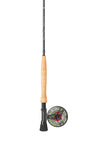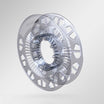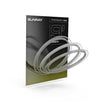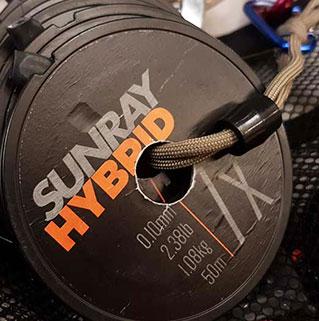Tippet is a very important part of my fishing equipment, even more important than a fly rod or a reel.
Many will wonder about this statement because a rod or a reel seems to be more important to catch big fish. This is a clear fact! People spend 1000 Swiss Francs for a rod or a reel but when it comes to leader material most of them hesitate to spend 20 Francs or more for a spool. Don`t get me wrong I do like good and expensive rods.They are amazing casting tools but for fishing, I could get away with a cheaper one.
Very bad tippet does not anymore exist anymore really. However small differences can make the difference between success or failure. This is the reason I do not compromise on leader material. If the quality is right, I am willing to pay the higher price because I can rely on the material in hard fishing situations.
In nymph fishing, the choice is particularly delicate. There are several requirements that the tippet has to fulfil. We fish close to the bottom, so it should be abrasion resistant. In certain situations it should be stiff, but also sometimes soft and supple. Knots should hold well and should not slip or cut themselves under tension.

I have already tested many different brands during several hours and days at the water.
I've tried different knots, knotted again, changed, used fluorocarbon, then nylon again, caught fish, lost fish, cursed, reasoned and laughed !
Since March, I have a new leader material in use:
The "Hybrid tippet" from Sunrayflyfish is a special one! It is fluorocarbon-coated nylon.
In order to understand the advantages of this material, you must know the differences between fluorocarbon and nylon. The most important differences are the following.
Fluorocarbon:
-Is stiffer, harder and more abrasion resistant than nylon.
-Less elastic than nylon
-Does not absorb water and does not lose its break strength.
-Knots must be carefully tied, not all knots are equally good or suitable for Fluorocarbon.
-Material qualities are very different between brands
-Very expensive.
-UV radiation does not harm the fluorocarbon.
Nylon (polyamides):
Is softer and more flexible than fluorocarbon.
More elastic than fluorocarbon.
Absorbs water and loses break strength.
Nylon has a good knot strength.
Common knots can be used with good results.
Attractively priced.
UV radiation damages the nylon.

In my list, I have not mentioned two properties, which are chiefly attributed to fluorocarbon. That is the visibility and the sinking ability.
We’ve often heard that "Fluorocarbon is invisible under water!" because it has the same optical density (refractive index). This may be true under laboratory conditions. On the internet, you can also find various videos showing nylon next to fluorocarbon in a glass of clear water or an aquarium. Yes indeed the fluorocarbon is almost invisible in these pictures. At least for the human eye. On the river, however, different conditions prevail. The refractive index of water is dependent on the water temperature and of solutes in the water. This optical density of water is therefore different from day to day or hour by hour, from river to river. The refractive index of our Fluorocarbon that we use does not change however.
If fluorocarbon is invisible or not, remains a presumption.
Fluorocarbon is heavier and sinks in water. Yes, this is true! However, will it make a difference? Will it actually sink a nymph to the bottom more quickly than nylon?
Fluorocarbon is only slightly heavier than nylon, around 0.64 to 0.74 grams per cubic centimetre. This is a difference of maximum 0.000074 grams per centimetre of a 0.10 mm diameter tippet. One meter tippet of 0.10 mm diameter will be 0.0074 grams heavier than the nylon. This tiny difference will not make a nymph sink faster! In the overall picture and in flowing water, this minuscule value is negligible.
If you want to read more about fluocarbon vs nylon check the following links:
http://www.flyfishamerica.com/content/fluorocarbon-vs-nylon
http://www.bigindianabass.com/big_indiana_bass/the-truth-about-fluorocarbon.html
https://swiftflyfishing.com/blogs/news/15472069-cutting-through-the-bullshit-the-mono-vs-fluoro-debate
https://activeanglingnz.com/2016/01/04/the-fluorocarbon-myth/
Other characteristics of the tippet are more important to me. Which are they?
Fluorocarbon is stiffer than nylon. My nymphs are hanging much better off the dropper loops and they do not wrap around the main line so much. This is an advantage in strongly turbulent water and while fishing with heavy nymphs. Or if you are the lazy guy who does not like to knot new leaders. On the other hand, the stiff fluorocarbon will hinder the movement of lightweight nymphs or wet flies. Sometimes this makes the difference between catching a shy fish or not.
Depending on the situation, I decide between stiff / hard or soft / flexible.
On some days, the fluorocarbon also has an advantage. Unlike nylon, the fluorocarbon leader material is not so elastic. Once stretched it does not return completely to its initial length. This is usually the case with tight line nymphing. After a few drifts you will snag somewhere in the riverbed. Likely you think it is a fish. Automatically you are rising the rod to set the hook. This happens one or two times and your fluorocarbon is stretched out. Also stretching the material while trying to release the nymph from the ground will set a stretch in the tippet. The stretch remains in the material and a better direct contact to the nymph is the result. You have a more sensitive feeling compared against an elastic nylon tippet. However, beware! By stretching the leader, the fluorocarbon loses some of its break strength.
The direct contact to the nymph is why most fly fishers catch more fish with fluorocarbon, although they claim their success is because of the invisibility and the sink ability of the material. I think they just feel more bites due to the direct contact and therefore hook more fish. The hybrid tippet is located somewhere between fluorocarbon and nylon. It is elastic, but also very sensitive and direct. You feel very well what happens under the water surface.
Last but not least the hybrid tippet has an important and for me superior advantage over Fluorocarbon. It has an incredible knot strength!
A knot reduces the strength of every leader material whether fluorocarbon or nylon or Hybrid tippet.
Fluorocarbon does not knot very well because it is stiff and hard. The Hybrid Tippet makes extremely nice knots which are very durable. This means I can reduce the tippet diameter and still have a strong connection to my flies. A thinner tippet cuts better through water. I fish with less effort and get deeper. Getting faster to a certain depth means I can cover more water effectively. I have more chances to present my nymphs properly to the fish.

I was really amazed how well the knots sat. Even under the magnifying glass, they looked perfect. A well-seated knot is important. Many fish are lost because bad knots are tied. Moreover, there is no other more frustrating feeling than losing a good fish on a broken knot.
The knots of the Hybrid tippet did not just look good. Some tough fighting barbel have put the Hybrid tippet to the test this year, not a single knot failed.
Fluorocarbon does not absorb water. But this is exactly what happens with nylon. Water molecules are embedded in the structure of nylon and it loses some of its breaking strength. Not so the hybrid tippet. Since the nylon core is coated with fluorocarbon, no water can penetrate. It remains strong. Fluorocarbon is very resistant to abrasion, as is the hybrid tippet with its fluorocarbon coat. In addition, it remains soft and mobile and kinks much less than fluorocarbon. Normal nylon, on the other hand, shows signs of wear very quickly and has to be replaced more frequently.

I now use the hybrid tippet 90% of the time while fishing with nymphs or dry flies. It combines the advantages of fluorocarbon and nylon. Practically the best of both worlds.
Sometimes it is worth the money trying something new.






















